Ask any three dog experts for advice on making dog food and you’ll get at least six opinions.
It’s almost guaranteed to spark heated discussions whenever you bring up the subject. However, we’re wading into the fray, not to tell anyone to do it our way, but because we’ve been asked many times about our recipes. We’re not suggesting that anyone follow our way of doing things, just showing what works for us and our dogs.
Start of the journey
Our foray into making dog food at home started when Fran’s Boston Terrier Booker came home about seven years ago. He was just a little bit of a puppy, with terrible digestion. He was gassy, or he was vomiting, or he was constantly producing loose stools. His tummy growled almost all the time and none of the commercial foods we tried helped.
We tried different proteins, different grains, limited-ingredient diets, etc. You name it, we tried it. We tried probiotics, supplements, antacids – pretty much anything people we respected suggested. It didn’t work. He was too skinny and we could tell he was uncomfortable.
Lucky to know a pro
Fortunately, a friend of ours from agility training started a dog-food business from her home. Lisa did exhaustive research and started her company, sadly now gone, to help dogs with medical conditions. Her own dog had been diagnosed with Degenerative Myelopathy, and her own veterinarian suggested she prepare his food. It helped her Collie, and she wanted to help other dogs, too.
We started getting food from Lisa for our dogs – and, for the first time in Booker’s life, his tummy was calm and happy. When Lisa’s business got busier, Hope would go and help out in her kitchen preparing dog food. That’s how she originally learned the preparation.
Revising as we go
Lisa’s company specialized in making custom recipes for individual dogs. The vast majority of her customers got raw, frozen food. Lisa suggested to us that Booker may lack the ability to process raw, so his recipes were always lightly baked. Many vegetable nutrients are more accessible to dogs after baking, so that’s what we do.
We make 12 batches of food at a time, each containing 1.5 lbs. Meat, approximately 2 tablespoons of ground egg shell for calcium, 2 cups of chopped vegetables or fruit, and about four ounces of organ meat. The ingredients depend on the cost and availability, and our experience with our own dogs. The protein this week was chicken and the vegetables and fruits were:
- Beets
- Dandelion Greens
- Zucchini
- Celery
- Daikon
- Cucumber
- Apples
- Bok Choi
- Cauliflower
Grind it all up in the food processor, mixed together, put into a baking pan, and bake for about 40 minutes at 350 degrees Fahrenheit. Each batch is divided into eight portions and frozen.
For our dogs, we’ve adjusted the portions according to their activity, size, and metabolism. We only use ingredients that all of the dogs can eat. Booker cannot tolerate pork, so we don’t use it. Torque adores beets, so we use quite a few. Simon adores dandelions. He finds them in our yard and munches away!
If you want a veterinarian’s take on making dog food at home, watch Dr. Judy Morgan’s “Pup Loaf” video.
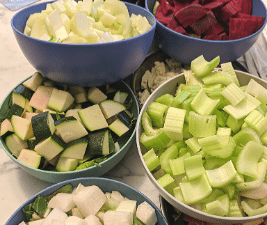
Produce ready to go. 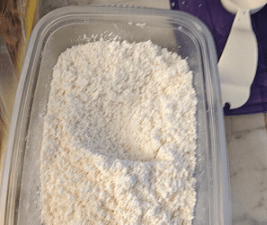
Powdered egg shell for calcium 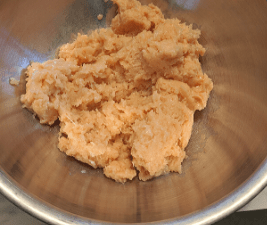
Chicken breast after grinding 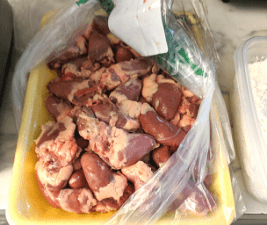
Organ meat, chicken hearts 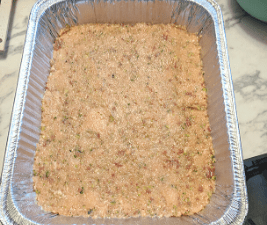
Single batch of dog food . 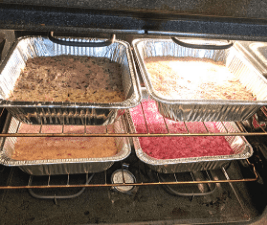
Four dog food batches ready to bake 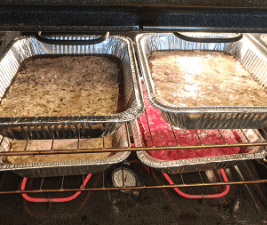
The cooked batches
What’s best for your dog
We’ve found ways to feed our dogs that work for us. All of our dogs also get a little bit of a commercial kibble for a couple of reasons. We want their bodies accustomed to it in case something happens and their homemade food isn’t available (power outage, travel). And we use it for training rewards.
Your choice for dog food has to work for you and your dogs. Collect the information you need, listen to the experts you trust, and decide for yourself.















How much would you feed a 8 yr old and 13 yr old border?
Of course you have to see how things go and modify as needed. The only gauge we can give you is by comparison. We divide each batch into nine servings. Booker, our 19 lb., 10-year-old, very active Boston eats a whole serving for breakfast and another for dinner, with no added kibble. Torque (28 lb. Frenchie) and Simon (19 lb. Boston) split a serving for each meal and have some kibble added. Torque is an “easy keeper,” and tends to gain weight quickly. Simon burns it off as soon as he eats it. I hope this helps!